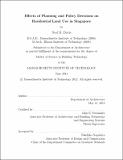Effects of planning and policy decisions on residential land use in Singapore
Author(s)
Davis, Noel R
DownloadFull printable version (11.75Mb)
Other Contributors
Massachusetts Institute of Technology. Dept. of Architecture.
Advisor
John E. Fernández.
Terms of use
Metadata
Show full item recordAbstract
A study of current land use in Singapore shows that through effective long-term space planning, the island city-state has maintained an adequate stock of developable residential land to meet its most ambitious maximum population projections. Two indicators of residential land use efficiency are defined: Residential Land Use Footprint, [Lambda]r, measures the per-capita residential land requirement; Mean Residential Redevelopment Time, [Tau]r, defines the weighted average time for the government to redevelop a typical plot of residential land. A dynamic stock-and- ow model is described to calculate the historical residential land use footprint and mean residential redevelopment time between 1990 and 2011. Finding that the primary driver of residential land use footprint is the change in household occupant density, a System Dynamics model is developed to simulate the historical housing price, supply response, and occupant density. Using a stock management structure to modulate housing supply and commodity dynamics structures to determine housing prices, the calibrated model is used to forecast the behavior trends of several housing policy and population growth scenarios.
Description
Thesis (S.M. in Building Technology)--Massachusetts Institute of Technology, Dept. of Architecture, 2012. This electronic version was submitted by the student author. The certified thesis is available in the Institute Archives and Special Collections. Cataloged from student-submitted PDF version of thesis. Includes bibliographical references (p. 191-197).
Date issued
2012Department
Massachusetts Institute of Technology. Department of ArchitecturePublisher
Massachusetts Institute of Technology
Keywords
Architecture.